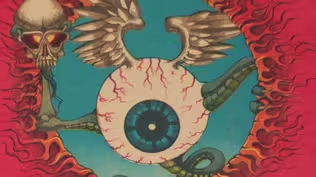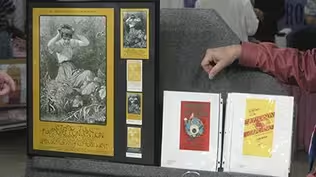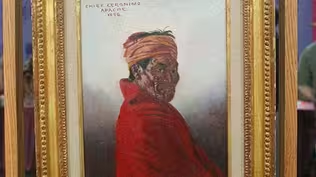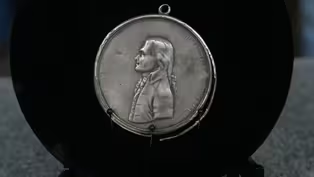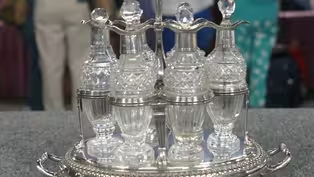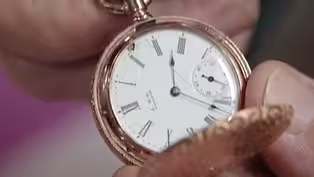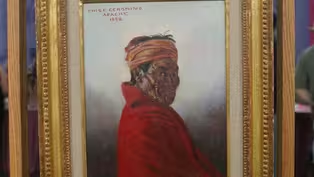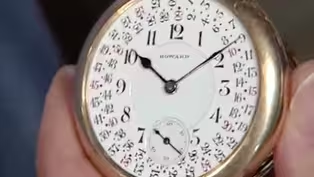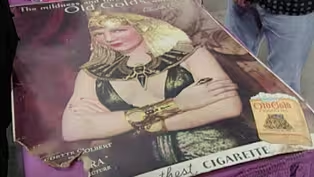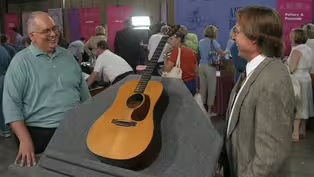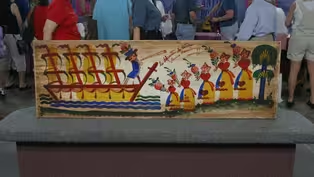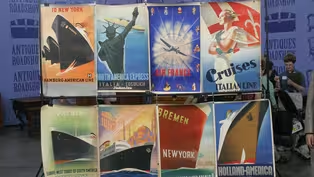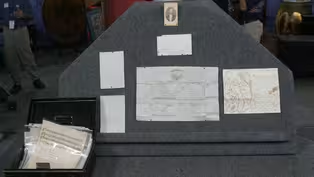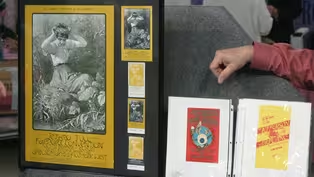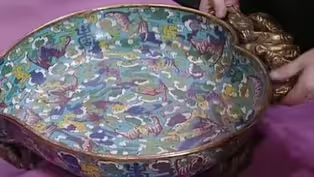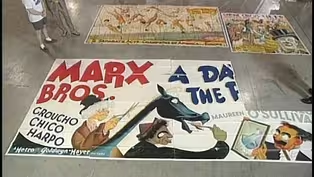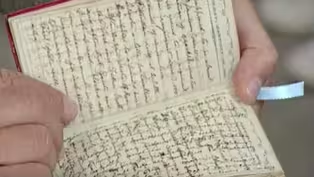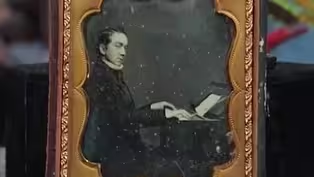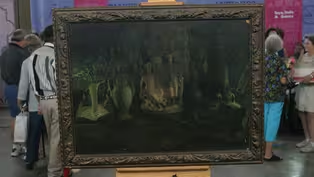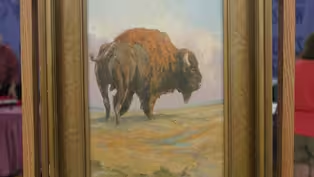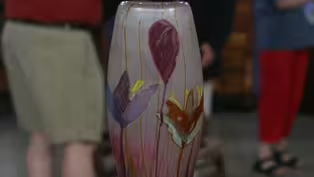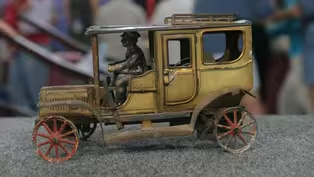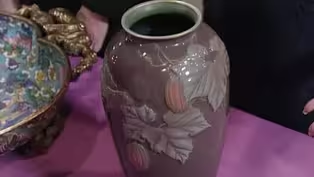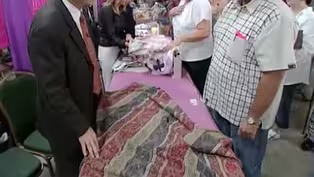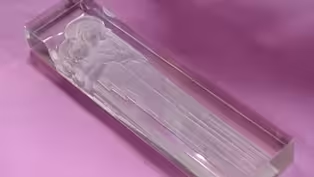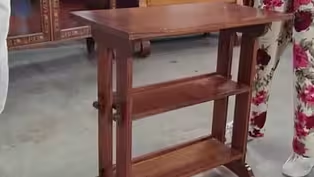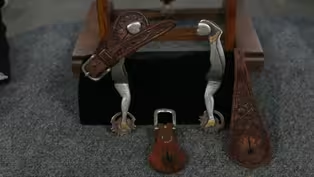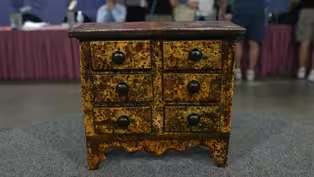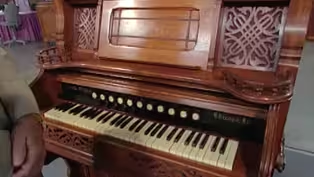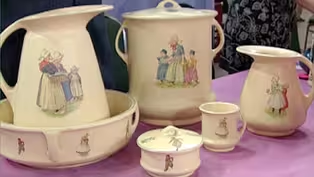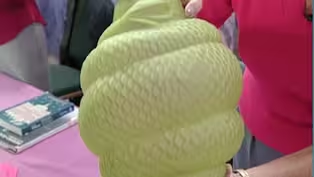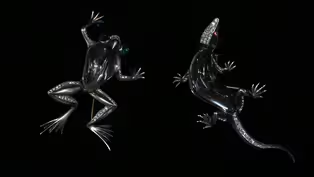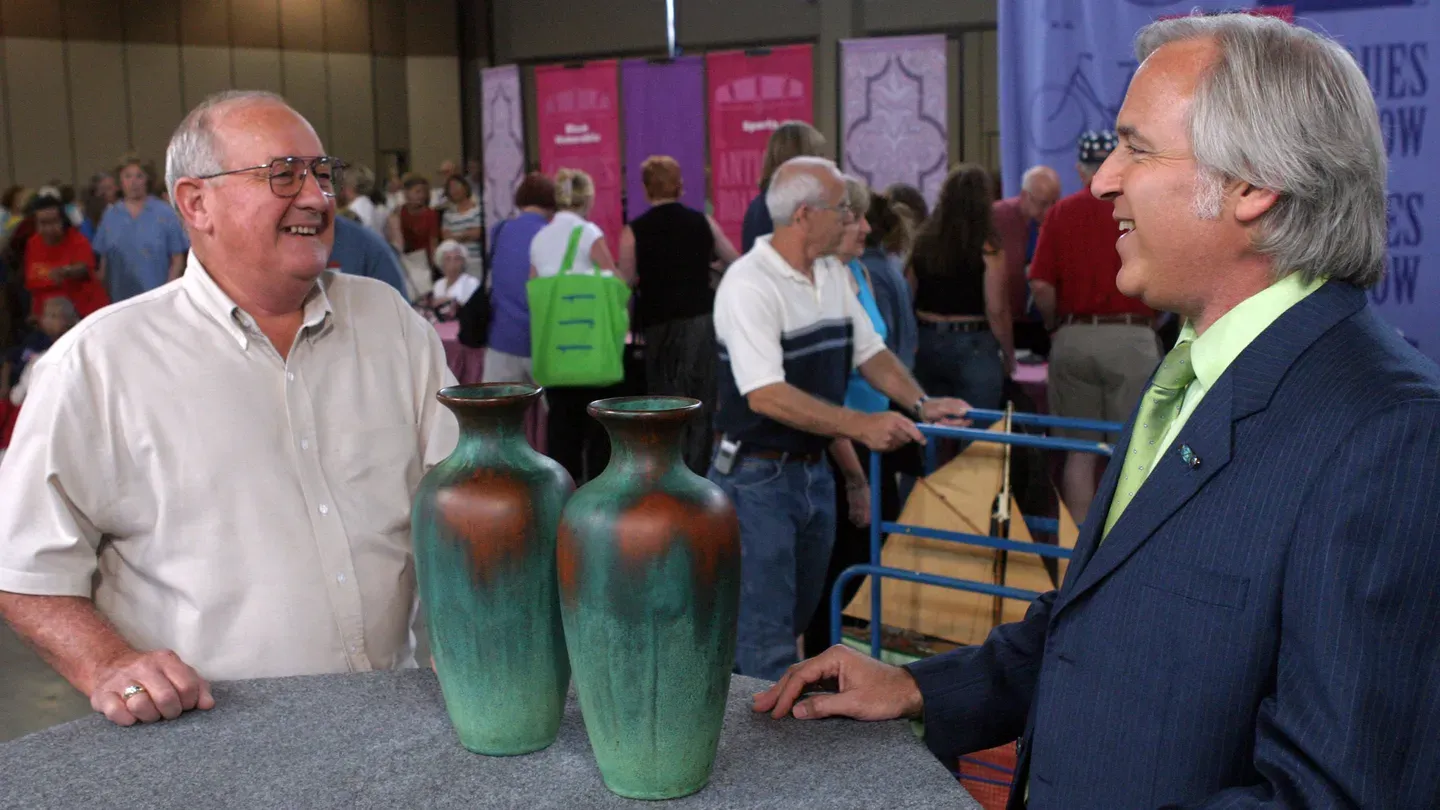

Vintage Oklahoma City
Season 22 Episode 24 | 52m 32sVideo has Closed Captions
Revisit updated appraisals from 15 years ago, including a treasure that doubled in value!
Revisit OKC appraisals from 15 years ago that have been updated with today’s market value, including Bill Graham handbills, a Gallé Marquetry vase made around 1900, and Art Deco travel posters. Which has more than doubled in value since 2003?
Problems playing video? | Closed Captioning Feedback
Problems playing video? | Closed Captioning Feedback
Funding for ANTIQUES ROADSHOW is provided by Ancestry and American Cruise Lines. Additional funding is provided by public television viewers.

Vintage Oklahoma City
Season 22 Episode 24 | 52m 32sVideo has Closed Captions
Revisit OKC appraisals from 15 years ago that have been updated with today’s market value, including Bill Graham handbills, a Gallé Marquetry vase made around 1900, and Art Deco travel posters. Which has more than doubled in value since 2003?
Problems playing video? | Closed Captioning Feedback
How to Watch Antiques Roadshow
Antiques Roadshow is available to stream on pbs.org and the free PBS App, available on iPhone, Apple TV, Android TV, Android smartphones, Amazon Fire TV, Amazon Fire Tablet, Roku, Samsung Smart TV, and Vizio.
Buy Now

ANTIQUES ROADSHOW 2025 Tour!
Enter now for a chance to win free tickets to ANTIQUES ROADSHOW's 2025 Tour! Plus, see which cities we're headed to!Providing Support for PBS.org
Learn Moreabout PBS online sponsorshipYour great-grandfather and his friends look fairly armed and dangerous in this photograph.
Well, actually, that's a family photo.
Really?
APPRAISER: Yes.
You're kidding.
(laughs): Man.
Boy.
That just almost leaves me breathless, because I had no idea.
♪ ♪ MARK WALBERG: It's been 15 years since "Antiques Roadshow" visited Oklahoma City, and in that time, the antique market has gone haywire.
The market for African-American art has skyrocketed in the last five years.
APPRAISER: The market for this stuff has dropped considerably.
The Chinese items are very popular these days.
WALBERG: Antique values constantly change based on buyers' interests.
What was once a treasure can soon become trash.
Let's see how these pieces of concert ephemera have fared in this rockin' market.
APPRAISER: This a collection of Bill Graham material related to his concerts-- promotional material.
MAN: Right.
The vast number of collectors of this material go for the posters.
You have one example of a poster here in your collection.
Here is the poster.
You have the flyer, and you have the tickets.
For every poster that Bill Graham did, just about, he did a handbill.
Very few people collect the handbills.
They might collect a poster and then say, "I'll get the handbill to go with it."
But you've amassed an almost complete collection of every Bill Graham handbill.
Is that right?
Yes, I lack three.
There are three that are missing.
What made you decide to focus on that?
Well, two things-- storage space, and I love miniatures, and each one of these is a little miniature piece of art.
Exactly-- it's a miniature poster.
Dealers just love Bill Graham, because he numbered all of his posters.
Exactly.
You want to point out the number on that one there?
This is 231.
And this here, the Jefferson Airplane, is number one.
Exactly.
That was the first in the series.
Yes, sir.
And people are familiar with this artwork, of course.
This is Wes Wilson.
And this is the height of the psychedelic San Francisco movement.
Whenever you refer to the San Francisco psychedelic movement, you're talking about Bill Graham posters, basically.
Exactly.
And this is an interesting piece.
It is very seldom seen.
I loved it because Jimi Hendrix was third on the bill.
Right.
And that's his first appearance at... After the Monterey Pop Festival, yes, sir.
Right.
This one says, "Copy."
Right, I've been looking for that one for 18 years.
This is sort of a Holy Grail?
It is the Holy Grail.
That's when Bill Graham took the five major rock bands to Toronto, and he shipped all the paper ephemera over land, and the truck was stolen.
And so there's almost none of these in existence.
Almost none.
And this piece here is the famous flying eyeball, by Rick Griffin.
Have you ever had a valuation put on this stuff?
Oh, just with the guys that I trade with.
I've never had a real appraisal.
Individually, they sell anywhere from $50 into the high hundreds.
What's the most you've ever paid for one?
I paid $1,200 for the one for the play, "Call the Beard."
That was a non-concert one.
Right.
Yeah, but it fits into the series, because it's... the numbers fit in.
Exactly-- it is one of the numbered.
It was a play that Bill Graham produced.
Right.
Yeah.
If you were to break up the set and sell them individually, you would gross about $18,000 to $20,000 for the entire collection.
But you have something else here.
Often, the total is worth more than the sum of the parts.
You have an almost complete collection.
Right.
As complete as anybody can get, practically.
And I would think that if you were to take this and sell it as a collection, a unit, and not break it up, at a pop culture auction, you'd be looking at in the range of $28,000 to $30,000 for this collection.
I'm shocked-- I'm shocked.
Well, that's... That's what comes from really paying attention to the details of a collection.
Thanks for bringing it in.
It was my pleasure-- thank you.
WOMAN: These spurs were passed down in my family from my great-grandfather.
He got land from the Land Run, didn't like it, moved to Indian Territory.
While he was there, a gentleman moved into Indian Territory that was from Ireland.
The story goes that he got into some trouble in Ireland, killed a man, his family sent him to Texas, he killed a man in Texas, so he moved up into the Kiamichi Mountains in Indian Territory, which is now Oklahoma.
He was able to hide out there from the Texas Rangers for a while.
But he was plowing his field, the Texas Rangers came for him.
He went for his gun, and the Texas Rangers went for him.
Nobody really knew anything about him in the community, so they auctioned off his belongings to pay for his burial.
So my great-grandfather, which is the guy in the black here, bought the spurs from the auction.
They were later passed down to my grandfather, who is actually the far guy here in the white, and then passed to my father, and then to me.
And this auction took place when?
It was in 1915.
The gentleman from Ireland was able to hide out until a little bit after statehood.
1907 was statehood, so...
Yes.
Your great-grandfather and his friends look fairly armed and dangerous in this photograph.
Well, actually, that's a family photo.
(laughs): Okay.
So those are all of his children and his wife, and a few others mixed in there.
(laughs): But yes, that's my family.
Well, let me tell you about these spurs.
Okay.
It all fits.
The spurs are McChesney, John Robert McChesney.
He made his first pair of spurs in Indian Territory, which is the eastern part of Oklahoma, in 1887.
Okay.
And he decided he was going to be a major force in the spur world, so he moved to Gainesville, Texas, about 1890.
Okay.
Well, he realized he wasn't quite the major force he thought he was, and he moved back to Pauls Valley, Oklahoma, in 1910.
So those spurs could have been made any time during that period.
All right.
They're called gal-leg or lady-leg spurs.
In this case, they're called double-mounted double gal-legs.
Most gal-legs, especially McChesney's, only had the gal-leg on the shank, which is this part back here.
These have them on the shank and going around the boot heel, and they're on both sides.
Right.
A lot of gal-legs were only on one side, so these are double-doubles.
Plus, they've got the heart button and the brass overlay on the shoe.
They've also got something that John Robert McChesney is said to have patented.
It's called the locking rowel.
And most rowels, when you hit them, they spin.
This one locks down.
Okay.
It's got that slot cut in it with a bar, so when you dig into a horse, that rowel locks down, and it just stops.
This is full silver overlay on both sides.
If you went to put them on the market, they're going to bring $2,500 to $3,500 easily, especially in this condition.
But it's hard to beat a story like that.
That's great-- thank you very much.
MAN: Sylvan Goldman invented the grocery cart here in Oklahoma City in 1937, and by 1940, he was mass-producing.
There's a label here on the front of the cart-- Folding Carrier Company, Oklahoma City.
APPRAISER: It's a neat piece, but the value is really more of a novelty.
It's not a real valuable piece.
It's probably worth a few hundred dollars.
After spending, like, 30 years in the grocery business, it's kind of unique to have one.
I just inherited it from my husband's family.
His great-grandfather came to Oklahoma in the fall of 1893 for the Cherokee Strip Run, when Oklahoma was settled.
Then he went back to Kansas, married, and brought his bride here in March of 1894.
The family lore is that the watch came along in a covered wagon.
It's a 4,300,000 watch.
It was made in 1889.
There's a good likelihood it was in the covered wagon.
It's a Waltham watch-- it's worth about $300.
When it came up for auction, I just liked it.
I guess I was fool enough to pay enough money to get it.
(laughs): How much?
$100.
The scales on the serpent are broad, not particularly well defined.
His face is almost childlike in its simplicity.
Where did you fight in World War II?
In the European theater.
I found that in France, in Alsace.
We sheltered in a glass factory there, and this was in the stockroom of that.
And the Germans run us out, and when we left, I took it with me.
I've been to that same factory.
It's still there, by the way.
It's the Lalique factory in Wingen-sur-Moder in Alsace, and they made this just before the war.
So it would've been there in the early '40s.
This was a heavy thing to put in your backpack, but you brought back a good piece.
You didn't bring back the most valuable piece, I'll warn you.
There are other things, even smaller things, that would be more valuable today.
The religious Lalique that was made mostly in the '30s has some value today, but not a great deal.
This one would only be worth in the hundreds of dollars, I'm afraid-- maybe $600, $700.
Originally, this has a little wooden base, and that would add to the value.
My father, when he graduated high school in 1937, got a scholarship to go to Paris, and he collected these posters when he was there in Paris.
Then the Germans invaded, and he was forced to flee the country, and went to Denmark, where he got put in prison because he had no money.
He got money wired to him from my grandfather, they got onboard ship to head back to the United States, and it was torpedoed on the way to the United States and had to limp into New Orleans.
And the posters made it back to Oklahoma City, and were stored until about three months ago when I found them upon going through the house on my mother's death.
And these are only a sampling of all the posters.
Right, right.
How many were there all together?
We counted approximately 65 to 70.
And I have chosen from among the 65 or 70, by and large, posters that have to do with ships.
Now, I've also included one airplane poster to show that the collection, it's multi-faceted.
Right.
It's not just ships, it's also airlines and Air France.
When I look at these, what I see is a rather interesting collection of Art Deco travel images, really from the golden age of travel.
Right, right.
They're mostly from 1938 and 1937.
Seven, right.
And within the poster world, one of the things that collectors look for... Yeah.
...are powerful Art Deco images.
And that's what we have here.
Some of these I have sold before at auction.
Okay.
Some of them I have never seen before.
That makes two of us.
And I am familiar with the artists.
They're all signed.
Some of the artists are more famous than others.
Right.
They're not all in great condition.
Two of these posters actually have a swastika on them: the Bremen poster here...
Yes.
...and then by you, the Patria poster.
The swastika was the German flag.
These posters do pre-date the Second World War, but people don't like posters that have swastikas on them because of all the negative connotations.
Right.
So should I give you the good news, or should I give you the bad news?
Oh, give me the bad news first.
Well, the bad news is, the posters really, by and large, are in the kind of shape where it will take maybe $10,000 to $15,000 to restore the whole collection.
Now, on the other hand...
Yes.
The posters that we have hanging here, these eight posters...
Yes.
I've tallied them up in my mind, and I estimate, conservatively, at auction... Uh-huh.
...these posters alone are worth somewhere between $18,000 and $22,000.
For just these eight.
$18,000 and $22,000, just these eight?
And for the rest of the collection, again conservatively, once restored...
Right.
A total of $40,000 to $60,000.
Wow, that's amazing.
It's a good thing I don't faint.
WOMAN: This was my mother's, and the other one I found on a little shopping spree.
APPRAISER: And what made you look for another one?
You kind of liked the one that she had?
I did, and I have had people show interest in it, so it intrigued me.
Well, the bellies are the prominent piece.
Of course, you've got eyes and you've got rhinestones, but the bellies are made out of Lucite.
And it's a good thing that Lucite came along when it did, a new form of plastic, simply because so many metals were being used in munitions plants during the war.
They substituted the acrylic for a lot of other gemstones, because it could be dyed different colors.
Also, these appear to be gold, but yet, they're silver, and there again, they couldn't get the base metal, so they made the piece in sterling and then they put a coating of gold on the top of it.
So it was like a vermeil finish.
And they have a design patent number on the back.
So one of them was made between 1944 and 1945, and the other was made between 1943 and '44.
This is the older of the two, here.
And these were made by Trifari.
It has the crown and "Trifari" under it, which is a very, very collectible name in costume jewelry right now.
And the clear Lucite is now called "jelly bellies."
When they first came out, they were called "clear bellies."
How much did you pay for this little slithering critter here?
Well, he was a real bargain.
He was marked $45, but just so happened everything in the shop was half-price.
Ooh, he... anything you get half-price is a bargain, I agree with that.
(laughs): Yeah.
I have seen these priced, individually, as low as $700.
I've seen them also priced at $2,400.
Oh, my.
This one is missing some stones, and I'm wondering, should I have them replaced?
Oh, definitely, because it's going to make it more wearable for you.
They should be not more than three dollars apiece.
Okay.
WOMAN: I was very interested in folk art painting, and I knew about Peter Hunt.
And when we were at an antique show in Minneapolis, I happened to spot this Peter Hunt bench.
And it's not my husband's sort of thing, but I convinced him that we should buy it.
It stayed at the end of our bed, and it's been there for ten or 15 years.
APPRAISER: The exciting thing here is really the painting on the top.
Tell me what drew you to buy this piece.
The colors and the little figures, and I felt we were very fortunate to find it.
I hope it really is a Peter Hunt bench.
Well, it's a wonderful bench, and it's painted in the mid 20th century, in the 1940s.
Peter Hunt was a decorator and a man about town in Provincetown and Cape Cod region in Massachusetts.
And he had a shop where he sold old furniture that he had hand-painted himself.
And the reason that I think this is particularly interesting is that he is drawing on, when he painted this, a long tradition of folk painters, over the last two centuries, of the Pennsylvania Germans and other painters who were decorating furniture.
The painting on this is very fun.
It's a depiction of a boat departing with wonderful ladies here offering flowers up at the departure.
The inscription here is in French, and it talks about the departure of a boat, and there's a date after that that looks like '44, which is on the right time frame for when Peter Hunt was sort of at the height of his work.
Below that, you can see his signature, "'ovince," which is a shortened version of "Provincetown," which is just locating it, and it's his way of signing the piece.
You were curious about whether this was, in fact, by Peter Hunt.
In a new emerging market like this, there's very little scholarship to go on.
Peter Hunt published books on how to paint, so we know that he was influencing lots of other people.
Right.
But I do think this was painted by Peter Hunt.
The way the paint is rendered on the top of this is very fluid and painted with great ease.
I saw that, too.
And that's a difficult thing to copy if you are only emulating what someone else is doing.
It tends to look more strained and carefully done.
Right.
So I think it's a wonderful bench, and I think you bought it at a great time in the market, and maybe down the road, this will be worth exponentially more.
How much did you pay for it at the show?
I'm pretty sure it was $225.
I would expect, in the current market, for it to be worth probably $1,000 to $1,500.
My goodness.
We, like, never do toilet sets on the show.
They were made to be used and abused.
It was made by the Roseville Pottery Company.
Roseville made a lot of pottery, and this was made in around 1915, just at the time when they were not doing hand-decorated artware and switching to production ware.
It's also in absolutely pristine condition.
These are family items that you brought in to us today, is this correct?
Yes, they are.
Yes, they are.
And they're both cloisonné.
The family's had them for years.
And the person, supposedly, that collected them had done a lot of travel.
APPRAISER: This is Japanese, it's Meiji period, 1868 to 1912, and it's done in this fabulous raised technique called "moriage."
This is worth, at auction, between $20,000 and $30,000.
(laughing): Oh, my gosh.
Marley, to you.
This is also very interesting.
This is Chinese cloisonné, also quite early.
It's from the late 1700s, the Qianlong period.
Any idea on the value on this one?
WOMAN 1: Well, after that one, I don't know.
It's worth a little bit less, because the market's a little softer for this type of thing, but it's worth in the range of about $5,000 to $7,000.
APPRAISER 1: When you walked in and we saw these, we just went, "Oh, my heavens!
Whoa."
MAN: It's very ornate, but I'm not sure what it is.
APPRAISER: Well, what you've got is a Civil War-era medical bleeder.
Oh.
You know the old pictures that you see of a doctor sitting around with a jar of leeches?
You're kidding, yeah.
This took the place of the leech.
That's good.
Get rid of the bad blood.
It's spring-loaded.
When you pull back the top portion, it releases it, almost like a switchblade knife.
The case is in very nice shape.
The piece fits into it really well.
We actually see a lot of these dug in Civil War campsites throughout the South, where the traveling Civil War doctors had them in their surgeon's kits.
Where did you get it at?
I bought it at an antiques store, and it just caught my eye.
What'd you give for it?
$10, $12.
Wasn't a bad investment.
Today, most of them in this kind of shape with the engraving will usually run about $200 to $350.
Okay.
A painful but nice piece.
(laughs) Well, I'm originally from Oklahoma.
The American bison is a cultural icon to me.
It's the monarch of the plains.
I found it in a gallery in upstate New York, of all places.
It seemed to be quite out-of-place there.
Yeah.
Did you pay a lot of money for it?
I paid about $3,500 for it.
Okay, about how long ago?
Within the last ten years.
And you obviously know the artist, Frank Tenney Johnson.
There's a museum in northeastern Oklahoma, in Bartlesville, by the name of Woolaroc, that had his paintings that I saw as a young kid.
Growing up, we'd take high school trips up there.
And, but it was a very different style.
Those paintings I saw were night paintings.
Yeah, Frank Tenney Johnson, he's known for those night paintings.
He does cowboy scenes, scenes of the range.
He was born in Iowa, trained in New York, came out to Colorado around the turn of the century... Oh.
And then went to California around 1920.
He was a commercial artist, did a lot of illustrations, and knew people like Russell and Norman Rockwell, and other people like that.
But I thought this was a nice thing that you brought the American bison.
I think it's the state animal here.
His market has really gone up.
It's gone up and down, but recently, it's very high.
There's a lot of interest in American painting, especially in American paintings of the West, and when you get something that's very iconic, very centered, very large bison there, it's something that collectors really like.
It's a little bit small for him.
There's only one other thing that I would say would be a detriment to this painting.
Okay.
And it's something I learned early on in the art world, is, what you have here is a southbound view of a northbound bison.
Okay, and so when you're looking at it, you're looking at not his best side.
Right, I see.
But I would say a value these days is probably in the neighborhood of $15,000 to $20,000.
Really?
Yep.
Wow.
WOMAN: I purchased it about 1995 in Milwaukee.
We were living there at the time.
And I bought it in a consignment shop.
I had done some museum work before, and I kind of thought it was an older piece.
And this consignment shop kept any information they had on it, and they had an appraisal of it in 1985.
I, upon looking at the appraisal, decided to go ahead and purchase it, and have had it in my home ever since.
And what did you pay?
I paid $175.
And what was it appraised for?
It was appraised in '85 for $5,800.
$5,800 in 1985.
Yes.
So you want to know from me... Yeah.
Is it real?
Yes, I do.
Is it worth $175, or is it worth $5,800, right?
Right, right.
Okay-- first, stylistically, it is exactly what you would want to see, essentially, for a Tang horse.
The Tang Dynasty, seventh, eighth century in China.
It is made of a type of high-fired earthenware.
And as you look at it, actually, you see the white?
Yes.
That is what's called a "slip."
And a slip is a very refined white clay that was put over the buff terra cotta pottery body, so when you painted it, the paint would stand out in contrast-- it wouldn't just blend into the background.
So that's something that's good to see.
It's a lively pose.
It's got a lot of action with a raised figure.
And when you lift it up... On the inside, you'll see there's a lot of dirt.
These were buried.
These were kept in tombs, and so a lot of the dirt would've adhered to the surface if it had come out of a tomb.
Right.
So I'm sure you saw that, and you're thinking, "Gee, this looks great."
The other thing that one sees is, here on the front leg, you can see that it's broken, so it's got some condition issues.
Right.
It's got all these features that make it look authentic.
It isn't authentic.
It isn't-- oh.
It's a $175 horse, which is fine.
Yeah, yeah.
It's what you paid, you didn't do anything bad.
But the reason the person appraised it so highly before is that they did not do the research, or they weren't experts.
Yeah.
They looked at the surface appearance, they saw the dirt, they saw the slip...
Right.
They read a book, and they thought, "Gee, this is right."
Yeah.
But when you look at this break... And this had been bought in the 1920s from the woman that owned it, I believe you told me.
Yeah, that's what they said.
There's a metal armature in this.
Well, I saw that, yeah.
Which doesn't make sense.
In addition to that, you wouldn't find this kind of high-fired pottery.
So what this is was a purposefully made fake in the 1920s.
That's why they put the dirt on it... Oh That's why they put the slip on it, and they wore the slip off, because you don't see the slip on the rest of the surface.
Yeah, yeah.
It's just where it's gone into these little spots.
Uh-huh.
They've made it appear as realistic as they can, because they wanted to fool people.
Yeah.
So it wasn't made as a replica to take home as a museum copy.
It was made to fool people, and we hope that the other owner wasn't fooled.
Yeah, I hope not, too.
So it's a good lesson-- don't rely strictly on documentation.
Go to an expert, somebody who really knows the subject.
Right.
I love him regardless of what he's worth.
I think he's got a lot of energy in him, and...
He does, he's perfectly great.
You paid the right price.
Good, good.
And it's a good lesson for a lot of people, and I'm delighted you shared it with everybody.
It's really helpful.
Well, thank you.
Thank you, I appreciate it.
Thanks for bringing it.
It belonged to my father, and he bought it new in 1937 from a music store in Shawnee, Oklahoma.
Uh-huh.
And he played it in a band for quite a few years, and then when he entered the service, it kind of sat around for a long time.
So you remember the instrument being around the house as a child?
Oh, yeah.
I was never allowed to touch it.
Ah.
So can you tell me what's been done to it since you had it?
Well, my dad played it up until 1986.
And at that time it was...
The frets were wore out, and it would buzz and...
When he tried to play it and everything, so I contacted Martin Guitar.
I was lucky, because there was a gentleman here in Oklahoma City that could repair it.
And he refretted it and reset the neck, and has a couple of little minor cracks in the side that he repaired.
But while it was in the shop, my dad passed away, so he never got to play it.
Oh, I see.
It's a 1937 Martin D-18.
At the time, it sold for around $75.
Right, yeah.
It was the simplest of this Dreadnought guitar.
It was the least ornamentation that you could get.
But as time has gone on, it's proved to be a very desirable guitar amongst professional musicians.
There have been some things changed about the instrument.
If you look on the top here, there's a couple of holes that have been filled.
Yeah.
There are some repairs on the side, and some finish touch-ups, but still, there are no cracks in the instrument, it's structurally sound, obviously had a very good repair job, and is in great playing condition.
Has anyone given you any indication of its real value?
No, not really.
I know there's a couple of guys at music stores that have offered me $300 or $400 for it, but I knew it was worth way more than that.
Usually, when an instrument's had some alterations, it affects their value greatly, but being that this is such a prized instrument for its sound, it still is of significant value.
In pristine condition, this instrument would bring somewhere in the neighborhood of $18,000 to $20,000.
Wow.
But still, it's a very nice thing, very desirable.
I think its value would be $12,000 to $14,000.
It is the right year and the right model.
If it were two years later, its value would be half that.
Really?
(laughs): Pretty good investment for $75.
MAN: Well, I brought this painting of Geronimo.
I always wondered if that was a real painting or not.
APPRAISER: How long have you owned it?
I can't remember what year it was, but I've had it quite a while.
I got it from a little shop not too far from here, and I just liked it because of the character in his face.
Well, he does have quite a bit of character.
The name of the artist is Elbridge Ayer Burbank, and it's signed here in the lower left.
He was known for painting Indian portraits.
He was from the Midwest, from Illinois, like many of the American Western painters were.
He studied at the Art Institute of Chicago, so he had a lot of training, and he started life as an illustrator, a lot like Remington and Russell.
But around 1898, he made it his goal to paint Indian portraits, and he painted over 1,200 Indian portraits from 125 different tribes.
And his claim to fame is that he's the only artist who ever painted Geronimo from life.
Really?
So... yes.
So that's quite exciting.
If we look on the lower right edge here, we see "Fort Sill, OT," meaning Oklahoma Territory.
Well, one thing, while we were here at the show, that we discovered after you brought the painting to us, is an early photograph of Geronimo at Fort Sill with the head of security who was guarding him, named David Alexander Hadden, and the people who brought this were actually descendants of Hadden.
Oh, really?
So it's quite interesting to see what Geronimo looked like here, vis-à-vis here, because he's wearing quite a fancy headdress.
Now, in terms of the authenticity, the signature looks very plausible, it's exactly what you would expect.
But in terms of evaluating a painting, it's often best to actually look at the reverse of the painting.
And this is a painting that's an oil on canvas board, and here we have the board on the back.
And if you'll note, there is a remnant of a label here.
Now, part of the label is missing.
This label actually is a label for a gallery called Kennedy Galleries, which is in New York.
And people who are familiar with American art and with the Kennedy Gallery label would recognize it.
It says that it's of Chief Geronimo and by Burbank.
And since this is a very reputable gallery that handled a lot of Western art, this makes a lot of sense and helps verify that what we're seeing on the front is accurate.
Now, have you ever had the painting evaluated?
Do you have any idea what it's worth?
No, I don't.
And how much did you pay for it at the time?
You know, it's been so long, I can't remember.
It wasn't much at the time.
A painting of Geronimo recently sold at auction for around $4,000.
Really?
Yes.
Now, that painting was larger than yours, but Geronimo was more head-on in terms of the way he was sitting, and it was not as finely done.
The face did not have as much character.
So I think, actually, although yours is smaller, it's a better painting, and I would evaluate it at $6,500.
Really!
Yes!
You're kidding.
No, not at all.
It was my sister's.
She found this underneath the floor, face down, covering a hole that would've been, I guess, the ceiling from the downstairs.
The date is clear, because this is Claudette Colbert in "Cleopatra."
And it's a tie-in piece for cigarettes.
I bought this in about 1963 or 1964.
They wanted two dollars for it, and I'll tell you, it was tough.
I didn't know if I could spend the two, but a friend talked me into go ahead and buy it.
It's a great little book rack, known as a Little Journeys book rack, made by the Roycrofters in East Aurora, New York.
If you bought all 24 volumes of "The Little Journeys," he would give you the book rack.
APPRAISER: We have a Civil War diary of who?
WOMAN: George Washington Rhodes, my great-grandfather.
Paper was very scarce.
They would write this way, then they'd turn it.
This is a great example of what's called "crosswriting," probably worth $1,000, $1,500.
Wow.
When I was a child and I was at home, when we'd have Iranian New Year, my mother set up the haft sin for the Iranian New Year.
Yes.
This was always in our former living room on the back of the sofa, and she would only put it out for that... You know, at that time.
It's a very finely woven shawl.
What's interesting is that it's made in India for the Persian market, and they're extremely fine, and this piece was actually originally about ten feet long.
But if you look carefully, there's a seam that runs across from one edge to the other, and that's been shortened down to about six or seven feet.
The value is going to be in the range of $3,000 to $4,000, even though it's been cut down.
WOMAN: It has been in my family for a number of years.
It was my granddad's.
He passed it on down to his elder son.
When he passed away, he gave it to my dad, and when my dad passed away, then it has come to my brother and I.
Do you know anything about it?
The only thing I did know is that it was a peace medallion from Thomas Jefferson.
I had heard that the Lewis and Clark expedition took several of the peace medals along with them, and that's about all I really know of it.
It's a very rare peace medal, and they were given to the Indians... Uh-huh.
...as a token of peace.
Lewis and Clark carried these with them on their expedition, which Jefferson sponsored.
Uh-huh.
It was 1803 and 1804.
This was made in two pieces.
I don't know whether you noticed that or not.
But it's two pieces of metal that they struck then put together with this rim.
And, as I say, it's a very rare medal.
I've had a number of peace medals.
Really?
I've never had a Jefferson.
A real Jefferson.
Oh, my goodness.
There are a number of reproductions, but this is real.
I think it would be in the range of around $40,000 to $50,000.
Oh, my God.
I mean, it's a really rare piece of Americana.
It's a big piece of history.
Well, I'll be.
Never thought it would be worth that much.
Should I have it fixed?
The rim?
That was... By a professional, yeah.
My daughter took it to school and showed it off and... Well, don't show it off, don't pass it around so much.
(laughing): We may not do that anymore.
No.
This is the first time we've had examples of Clewell Pottery on the show.
Oh, yeah?
And these are two beautiful examples.
You said your daughter found these?
Yeah, she bought them at an estate auction about 15 years ago.
I believe she paid, I'm going to say in the neighborhood of $300, $325 apiece for them.
Charles Clewell was making his metal-clad pottery from about 1903 till about 1950.
He was influenced by a piece he saw that J.P. Morgan had had, it was unearthed outside of Rome in the late 19th century.
It was an early Roman piece, and what he did is, he covered his pieces with a metal coating, and then he would patinate them and freeze the patination process, so these colors would be fixed.
He was from Canton, Ohio, and he bought blanks from, like, the Weller Pottery in Roseville and Owens and Knowles, Taylor & Knowles.
Curious thing about Clewell is, when he died, he instructed his heirs to burn his formula.
Oh, really?
So that it couldn't be replicated, and so the process is now lost.
There are a number of them out there.
He made pottery for many years, but very seldom do you see pieces that number one, are this large.
Okay.
Number two, I've never seen a matched pair this large.
I see.
And I've seen hundreds of pieces of Clewell.
Number three, the color combination's really good on these.
You have that really nice rust color mixing with that verdigris green.
And on top of that, in spite of what they say that the colors are fixed, if people try and scrub them, they can clean the colors off, so very often you see Clewell pieces where the colors are shredded, and these are nice and bright and crisp.
They're also very clearly marked.
Typical Clewell mark incised into the bottom, or actually more like etched into the bottom with production numbers.
There's just nothing wrong with these.
They're absolutely perfect.
If you cleaned them, what would you use to clean them up with?
I would probably just use a slightly damp cloth and leave it at that.
All right.
Because I think the surface is a little more fragile than we've been led to believe.
All right.
In terms of value, again, I've not seen a matched pair, but I think individually, they have to be worth at least $3,000 to $4,000 apiece.
A matched pair might bring $7,000 to $8,000.
You said $7,000 to $8,000?
Yeah, for the pair.
For the pair?
And it wouldn't surprise me if they brought more, because it... to find a pair like this so perfectly matched would be very difficult.
My word.
We had no idea these were worth anything like that.
We... goodness.
MAN: My wife and I was out in western Kansas pheasant hunting, and on the way back, we stopped at this little old dumpy antiques store in Macksville, Kansas.
And unbeknownst to me, she purchased it.
She gave $12 for it.
APPRAISER: $12?
Yeah.
And she kind of hid it from me... Uh-huh.
...until Christmas, and she gave it to me for my Christmas present in 1965.
And I don't know anything about it.
You don't know who made it or anything?
No, I couldn't see any markings on it.
It was made by a company called Georges Carette, they were a German company, even though he has a French name.
He was a Frenchman who moved to Germany in the early 20th century-- the late 19th century.
He made a whole line of wonderful toys.
Yes.
Now, this was made around 1905, and this was a period when cars were for the very rich, and the toys based on them were for the very rich.
Also.
It's called a Carette Limousine, it has the original painted tin driver, here, and has wonderful features, including opening doors and actually has a brake mechanism.
It was quite a deluxe little toy, complete with a glass windshield.
But it's kind of rough condition, isn't it?
Yes, it is.
Well, it's a good thing you didn't do anything to it.
One of the things that we've taught a lot of people on the "Roadshow" is that, you know, restoring things or cleaning them up, you can really make a big mistake.
Yes.
Each case is a separate case.
It depends on the object, it depends on what's wrong with it, all this enters into the mix.
It's not a case where cleaning it or adding replacement parts would damage the value.
I sold an exceptional example of one of these about three years ago at auction for $5,700.
(muttering) In mint shape?
Excellent condition-- not mint, excellent.
Excellent, not mint, but excellent.
Now, if you were to sell this at auction as it sits, right now, I think it would easily bring $1,000.
But this is an eminently restorable and fixable toy.
The motor can be repaired, these wheels could be properly repainted, and you can see it has really very good color.
I think this thing would clean up very easily.
I think you would have to invest about $300 to $400 in restoring it.
And then it would easily bring $2,500, $3,500.
So here's a case where, if you fix it properly, you've enhanced the value.
(laughs): Man.
Boy.
MAN: It's a cruet set.
It's been in a box for years, and seven or eight years ago, somebody came by and took a look at it and said, "Geez, the hallmark's interesting.
You ought to have it checked."
So seven years later, I raced right down, and here I am, sir.
I know nothing about these.
I'm certainly glad you did.
It's English, what we call Georgian silver, which is sterling silver, and very beautiful cut crystal.
It's a six-bottle cruet stand, and it was made in London in 1805.
Good gosh.
And the maker is a gentleman by the name of Paul Storr, S-T-O-R-R, one of England's most famous late-18th- and early-19th- century silversmiths.
The very finest quality, the detail in the stand, the detail in the mountings, quality of the cut glass, the beautiful markings, which are on each one.
Do you have any idea what it might be worth?
(chuckles): I haven't a clue, and I had a heart attack in April, so you better come easy on me.
Well, I'm going to try to, but you might be rather surprised to find out that in a well-advertised auction, a piece of Paul Storr silver of this quality is somewhere in the $8,000 to $12,000 range.
I'm shocked.
(stammers): I can't speak so smoothly now.
(laughing) APPRAISER: These were meant to be put on the sides of barns, so as trains went by, people could see the advertisement for the circus.
The value of this poster unmounted to a collector is probably going to be between $3,000 and $4,000.
You've heard the old adage that size really matters?
Yeah.
In this case, it's a little bit of a liability.
Because these posters are so big, where would somebody put them?
You have an occupational portrait of a man before a clavichord, what's also known as half a piano, the sort of instrument carried by an itinerant preacher.
I'd put a $2,000 to $3,000 estimate on it.
You're kidding!
Nope.
Are you happy?
Yes!
Very, very shocked.
Well, it's a beautiful daguerreotype.
About every old farmhouse that I go in has got one of these in it.
These pump organs were really a part of middle-class America, the Victorian period.
Hymn singing and bible reading was very important to the American family.
Right.
Technology has outpaced them.
They take up a lot of room in any modern house today.
This watch belonged to my grandfather.
He worked for the Western Union telegraph company, installing telegraph lines along the railroad lines.
One day, he and his crew were in the tunnel.
His watch said the train would not come, but the train did come, almost killing the entire crew.
That watch got thrown against the wall of the tunnel, and this watch was purchased to replace it.
If you look at all the indicators, you can see it's almost overdone.
Usually we have five, ten, 15, 20.
This one breaks it all down into increments in two-tone red and black.
It's made by E. Howard and Company, Boston, Massachusetts.
This watch was manufactured in 1907.
Most railroad watches were gold-filled.
This one has a 14-karat yellow gold Dueber case.
This one has a hinge cover, again, very rare, very unusual.
So in a watch that I may have told you two years ago was worth $1,500, now I can confidently say it's worth around $3,000.
Wow, really?
Yeah.
That's very gratifying.
Well, I never knew my grandfather-- he died before I was born, so it's nice to have something that he owned and used.
MAN: I got this from an auction in Kansas.
APPRAISER: And how long ago was that?
About ten years ago.
It's called "Radio Nurse."
It was produced by Zenith, and it dates from around 1937.
It is actually a kind of an early baby monitor.
It sprang up out of the fear that was generated after the Lindbergh baby kidnapping.
You've got two parts to it.
You've got the guardian ear, which actually would sit in your baby's room, and then the speaker, which would go wherever you would want it in order to monitor it.
What's significant about this piece is the design.
It's an excellent example of modern design by a very famous Japanese-American designer called Isamu Noguchi.
Noguchi was born in Los Angeles, but spent much of his life in Japan.
Noguchi went on to design furniture, and he was influential to current American designers and architects all over the world.
And this is very typical of his design.
He's combining machine elements with the human form.
I mean, it's called "Radio Nurse," and this looks like a nurse's head, you can see the face, and then you can see her kind of hat draped around the back to the side.
And the reason it's so scarce today is because during the war, a lot of these were trashed because of the Japanese association with them.
And Noguchi, as a Japanese-American designer, his stock continues to rise, and this has become, like, a classic icon of his work.
And you see it in all the modern design collections in museums throughout the country.
You often just see this speaker.
It's not as interesting, this part, because it's not as interestingly designed.
It often gets thrown away.
And it's the original finish on it.
It's pretty significant to have it.
This case is okay-- it could be buffed up a little, but they're easily cracked, because it is Bakelite.
Yeah.
You remember how much you paid for it originally?
I believe it was $25, $35.
A piece like this, in the current market is easily in the $2,000 to $2,500 range, and I'm really excited that you brought it on, and thanks for bringing it in.
That's amazing.
MAN: Well, it was passed down through my family.
It came from my great-grandfather, letters that were written to him from his friend George Brown.
They went to school together in Baltimore, Maryland, before George joined the Army.
So explain to me who this gentleman is in this photograph.
Okay, that is George Brown, he was with the 7th Cavalry, and he was killed at the Battle of Little Bighorn.
This is an archive of a Corporal George Brown, who served in the 7th Cavalry with Custer and died at the battlefield on June 25, 1876, and correspondence after the fact from a friend of his, Private Kim, who served with him, to your great-grandfather.
Yes.
The Battle of Little Bighorn is a pivotal moment in American history.
Yes, it is.
And so anything that sort of survives from the 7th Cavalry and that event is pretty special-- and what is this here?
That's a map of what the battlefield looked like after the battle was over.
It was made by John Kim.
He was with the Major Reno group.
Mm-hmm, and what we have here is, this is actually George Brown's appointment as a corporal in the 7th Cavalry.
Yes, it is, yeah.
That's pretty impressive.
And this is George Brown's documentation of his trips in the Black Hills with Custer.
Yes, it is.
Do you know this letter over here?
That was from Kim, telling about finding George's body and being with Custer and E Company.
The letter is dated July 20, 1876.
It was after the battle, right.
And as you probably know, the battle was on June 25.
Right.
So here you have notes of his travels with Custer up until the battle, then he died at the battle, and then his friend continued his correspondence.
Yes, that's correct, uh-huh.
Yeah, it's really wonderful.
And I mean, I haven't had time to look through all these letters, but they're really special.
I believe it's a total of 23 letters, all told.
Do you have any idea of what this material is worth?
I had someone tell me that it might be worth $10,000.
I would think that $10,000 is a fairly conservative value, and I think that in the right environment, in the right circumstances, the whole archive could be worth around $25,000 or more.
That's very good.
That's a very special gift that your mother left you.
Yes, it is.
WOMAN: This belonged to my great-aunt, and she ran an antiques store in Colorado in the '40s and the '50s.
When she passed away, her estate was settled, and my dad received this vase, and then when he died, it became mine.
What did you dad tell you about this piece?
Did he know anything about it?
All they told me about it was that it was a Gallé vase.
Did you know who he was?
Not really.
Okay.
Let me tell you a little bit about who he is.
French man, his first name was Émile, and he was born in 1846 in Nancy, France.
His father owned a glass factory and a ceramics factory.
He kind of dabbled a little bit in ceramics and started working in glass himself.
And he took some of his glasswares to the Paris International Exposition, and they went over very well.
Gallé's biggest influence was nature, and you see that by the beautiful flowers that are on this vase, and you also see things enameled with insects and bugs, all kinds of organic-type things.
This was made around the turn of the century.
Émile Gallé died in 1904.
However, they continued to operate his glassworks until 1936, when they closed.
The quality of the pieces after he died kind of went down, and you would not see pieces like this produced after his death.
Earlier pieces like this are called marquetry, which is a technique that he made that we don't see very much of.
He also did things in enamel, and cameo glass, which are the things that we show most often here on "Antiques Roadshow," and that you see in the antiques stores.
We recognize the style of this piece, but we also see that it says, "Gallé."
Mm-hmm.
You told me that you hadn't even recognized that it was signed before.
No, we didn't recognize that it was signed until today, when we were holding it and waiting.
These things don't come on today's market very much.
If this piece came up at auction today, because of the size and because of the rarity, this piece would probably bring anywhere from $60,000 to $80,000.
You're kidding!
No, I'm not.
You know, that just almost leaves me breathless, because I had no idea.
I knew it had a value to it if it was actually Gallé, I knew that, but never that much.
Well, your great-aunt, she had amazing taste.
WALBERG: You're watching "Antiques Roadshow: WALBERG: And now, it's time for the Roadshow Feedback Booth.
My experience here was really cool.
I got lots of souvenirs, although I didn't appear on TV, but that's okay, my dad did.
I brought an arrowhead that my husband thought was very worthwhile.
As I always suspected, he paid too much, he pays too much for everything, and this was not worth much.
Now, all of a sudden, I think I like my wife's collection, and I'm way excited about it.
$600 for this ugly thing-- isn't that great?
He goes, "Oh, that's such a nice Windsor chair, that's such a nice Windsor chair."
Turns it upside down, he said, "Oh, it's such a nice reproduction Windsor chair."
We had a great time.
Oh, gosh.
Thank you.
I don't think they're going to use that one.
I was thrilled this morning to get to come.
I brought an old pottery field pot.
I forgot to take my high blood pressure this morning, so I'm a little uptight.
So I can go home and tell my husband I did good, and he'll be so happy with me, and I can shop some more.
Thank you!
It's only worth $100 to $150, but you'd have to break off my right arm to get it.
I live right here.
My dolly, I gave $40 for.
He has told me it is worth $2,000.
Which is absolutely taking my breath away.
It's a wonderful experience, I thank you ever so much.
WALBERG: I'm Mark Walberg, thanks for watching.
See you next time on "Antiques Roadshow."
Appraisal: 1801 Jefferson Peace Medal
Video has Closed Captions
Clip: S22 Ep24 | 1m 37s | Appraisal: 1801 Jefferson Peace Medal, in Vintage Oklahoma City. (1m 37s)
Appraisal: 1805 Paul Storr Cruet Set
Video has Closed Captions
Clip: S22 Ep24 | 1m 46s | Appraisal: 1805 Paul Storr cruet set, in Vintage Oklahoma City. (1m 46s)
Appraisal: 1889 Waltham Pocket Watch
Video has Closed Captions
Clip: S22 Ep24 | 36s | Appraisal: 1889 Waltham Pocket Watch, in Vintage Oklahoma City. (36s)
Appraisal: 1898 Burbank "Chief Geronimo" Portrait
Video has Closed Captions
Clip: S22 Ep24 | 3m 18s | Appraisal: 1898 Burbank "Chief Geronimo" Portrait, in Vintage Oklahoma City. (3m 18s)
Appraisal: 1907 E. Howard Railroad Pocket Watch
Video has Closed Captions
Clip: S22 Ep24 | 1m 8s | Appraisal: 1907 E. Howard Railroad Pocket Watch, in Vintage Oklahoma City. (1m 8s)
Appraisal: 1934 Cigarette Poster
Video has Closed Captions
Clip: S22 Ep24 | 28s | Appraisal: 1934 Cigarette Poster, in Vintage Oklahoma City. (28s)
Appraisal: 1937 Martin Guitar Model D-18
Video has Closed Captions
Clip: S22 Ep24 | 2m 32s | Appraisal: 1937 Martin Guitar Model D-18, in Vintage Oklahoma City. (2m 32s)
Appraisal: 1944 Peter Hunt Folk Art Bench
Video has Closed Captions
Clip: S22 Ep24 | 2m 50s | Appraisal: 1944 Peter Hunt Folk Art Bench, in Vintage Oklahoma City. (2m 50s)
Appraisal: 20th-Century Art Deco Travel Posters
Video has Closed Captions
Clip: S22 Ep24 | 2m 57s | Appraisal: 20th-Century Art Deco Travel Posters, in Vintage Oklahoma City. (2m 57s)
Appraisal: 7th Cavalry Archive, ca. 1876
Video has Closed Captions
Clip: S22 Ep24 | 2m 31s | Appraisal: 7th Cavalry Archive, ca. 1876, in Vintage Oklahoma City. (2m 31s)
Appraisal: Bill Graham Handbills, ca. 1970
Video has Closed Captions
Clip: S22 Ep24 | 3m 12s | Appraisal: Bill Graham handbills, ca. 1970, in Vintage Oklahoma City. (3m 12s)
Appraisal: Chinese Qianlong Period Cloisonné Dish
Video has Closed Captions
Clip: S22 Ep24 | 40s | Appraisal: Chinese Qianlong Period Cloisonné Dish, in Vintage Oklahoma City. (40s)
Appraisal: Circus Barn Poster, ca. 1940
Video has Closed Captions
Clip: S22 Ep24 | 26s | Appraisal: Circus Barn Poster, ca. 1940, in Vintage Oklahoma City. (26s)
Video has Closed Captions
Clip: S22 Ep24 | 21s | Appraisal: Civil War Diary, in Vintage Oklahoma City. (21s)
Appraisal: Daguerreotype, ca. 1855
Video has Closed Captions
Clip: S22 Ep24 | 28s | Appraisal: Daguerreotype, ca. 1855, in Vintage Oklahoma City. (28s)
Appraisal: F. J. Waugh Oil Painting, ca. 1925
Video has Closed Captions
Clip: S22 Ep24 | 1m 3s | Appraisal: F. J. Waugh Oil Painting, ca. 1925, in Vintage Oklahoma City. (1m 3s)
Appraisal: Folding Carrier Co. Cart, ca. 1940
Video has Closed Captions
Clip: S22 Ep24 | 28s | Appraisal: Folding Carrier Co. Cart, ca. 1940, in Vintage Oklahoma City. (28s)
Appraisal: F. T. Johnson Painting, ca. 1931
Video has Closed Captions
Clip: S22 Ep24 | 2m | Appraisal: F. T. Johnson Painting, ca. 1931, in Vintage Oklahoma City. (2m)
Appraisal: Gallé Marquetry Vase, ca. 1900
Video has Closed Captions
Clip: S22 Ep24 | 2m 44s | Appraisal: Gallé Marquetry Vase, ca. 1900, in Vintage Oklahoma City. (2m 44s)
Appraisal: Georges Carette Limousine, ca. 1905
Video has Closed Captions
Clip: S22 Ep24 | 2m 46s | Appraisal: Georges Carette Limousine, ca. 1905, in Vintage Oklahoma City. (2m 46s)
Appraisal: Japanese Meiji Period Vase
Video has Closed Captions
Clip: S22 Ep24 | 40s | Appraisal: Japanese Meiji Period Vase, in Vintage Oklahoma City. (40s)
Appraisal: Kashmiri-woven Shawl, ca. 1840
Video has Closed Captions
Clip: S22 Ep24 | 52s | Appraisal: Kashmiri-woven Shawl, ca. 1840, in Vintage Oklahoma City. (52s)
Appraisal: Lalique "Vierge à l'Enfant" Statue, ca. 1940
Video has Closed Captions
Clip: S22 Ep24 | 1m 1s | Appraisal: Lalique "Vierge à l'Enfant" Statue, ca. 1940, in Vintage Oklahoma City. (1m 1s)
Appraisal: "Little Journeys" Bookcase, ca. 1905
Video has Closed Captions
Clip: S22 Ep24 | 27s | Appraisal: "Little Journeys" bookcase, ca. 1905, in Vintage Oklahoma City. (27s)
Appraisal: Mahonri Young Sculpture, ca. 1910
Video has Closed Captions
Clip: S22 Ep24 | 1m 3s | Appraisal: Mahonri Young Sculpture, ca. 1910, in Vintage Oklahoma City. (1m 3s)
Appraisal: McChesney "Gal-Leg" Spurs, ca. 1900
Video has Closed Captions
Clip: S22 Ep24 | 3m 18s | Appraisal: McChesney "Gal-Leg" Spurs, ca. 1900, in Vintage Oklahoma City. (3m 18s)
Appraisal: Miniature Redware Chest, ca. 1840
Video has Closed Captions
Clip: S22 Ep24 | 33s | Appraisal: Miniature Redware Chest, ca. 1840, in Vintage Oklahoma City. (33s)
Appraisal: Pump Organ, ca. 1900
Video has Closed Captions
Clip: S22 Ep24 | 21s | Appraisal: Pump Organ, ca. 1900, in Vintage Oklahoma City. (21s)
Appraisal: Roseville Toilet Set, ca. 1915
Video has Closed Captions
Clip: S22 Ep24 | 24s | Appraisal: Roseville Toilet Set, ca. 1915, in Vintage Oklahoma City. (24s)
Appraisal: Snake Glass Vase, ca. 1970
Video has Closed Captions
Clip: S22 Ep24 | 23s | Appraisal: Snake Glass Vase, ca. 1970, in Vintage Oklahoma City. (23s)
Appraisal: Trifari "Jelly Belly" Pins, ca. 1945
Video has Closed Captions
Clip: S22 Ep24 | 2m 13s | Appraisal: Trifari "Jelly Belly" Pins, ca. 1945, in Vintage Oklahoma City. (2m 13s)
Providing Support for PBS.org
Learn Moreabout PBS online sponsorshipSupport for PBS provided by:
Funding for ANTIQUES ROADSHOW is provided by Ancestry and American Cruise Lines. Additional funding is provided by public television viewers.


